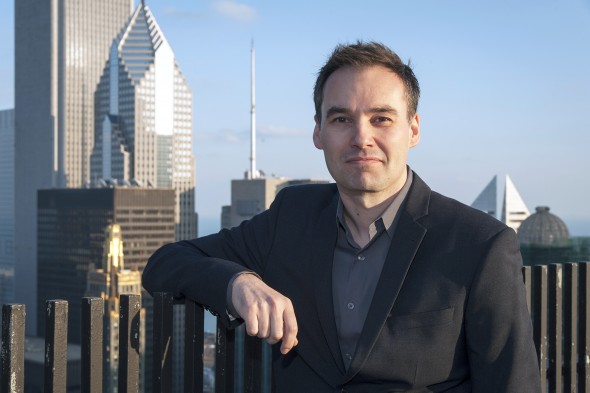Building support for Chicago’s role as catalyst for urban future

Alexander Eisenschmidt shares his research on Chicago’s development at exhibitions and conferences around the world. — Photo: Roberta Dupuis-Devlin
Although he’s lived in Chicago for only eight years, Alexander Eisenschmidt looks more deeply into the city’s development than many natives.
Then he urges others to see Chicago — and other cities — as a catalyst for the urban future. He shares the results of his research and speculations through exhibitions and conferences around the world.
His current exhibition, “Collective City,” is on view in Shenzhen, China, at the Biennale of Urbanism. It’s the latest of a succession of provocative shows that began a few years ago.
For the 2012 Venice Architecture Biennale, Eisenschmidt curated “City Works: Provocations for Chicago’s Future.” He recruited four renowned Chicago architects to model what he called “Chicago tropes.” Jeanne Gang considered the river; Stanley Tigerman, forms of shelter; UIC’s David Brown, the city’s grid design; and Urban Lab, a studio run by UIC’s Sarah Dunn and her husband Martin Felsen, looked at Chicago industry.
“I wanted to find four practices that cover areas that are typical for Chicago, but also typical for most of the industrialized world,” said Eisenschmidt, assistant professor of architecture.
Above the models, Eisenschmidt installed “Phantom Chicago,” a panorama drawing of hundreds of buildings that were proposed but never built.
The next year, the exhibition was reconfigured in Chicago at the city-owned Gallery 37.
Also in 2012, Eisenschmidt edited a book of essays, City Catalyst: Architecture in the Age of Extreme Urbanisation, in which he and other scholars examined the use of “the productive tension between the city and architectural form.”
Chicago was placed under a similar lens in Chicagoisms: The City as Catalyst for Architectural Speculation, a 2014 book co-edited by Eisenschidt and Jonathan Mekinda, who teaches art history and design at UIC, and funded by the Graham Foundation for Education in the Visual Arts. Ideas from the book prompted “Chicagoisms,” an exhibition at the Art Institute of Chicago.
He is completing his third book, The Good Metropolis, for which he received a Getty Foundation Library Research Grant as well as a Graham Foundation grant.
He describes it as a look at the city as catalyst since the early 20th Century, when many cities were seen as “formless,” he said.
“Alexander’s research is not just significant for its content,” wrote David Brown, associate professor of architecture. “It is equally significant for the way that Alexander enlists collaborators and contributors, as well as his insistence on making the pursuit of speculative architecture a public discourse.”
